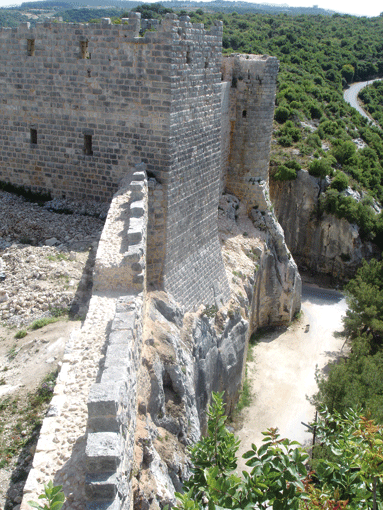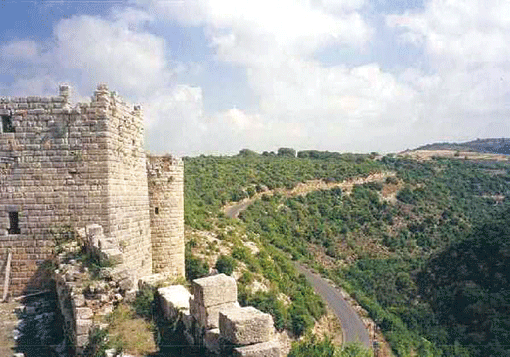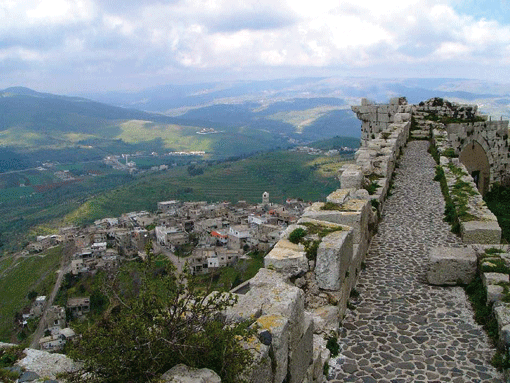
Travel
Castle Of Salah El-Din
Syria’s Impregnable
Historic Fortress

Declared World Heritage Site by UNESCO
By: Saad Bin AbdulAziz Alshabanat
Tourism in Syria is an industry that uniquely flourishes due to the extraordinary mixture of the country’s spectacular nature, fine weather conditions and rich archaeological treasures reflecting its history. Of such treasures, is the Castle Of Salah El-Din (Saladin), the structure of which was accomplished during different historical periods, thus representing different civilizations. The Castle of Salah El-Din is strategically situated in a mountainous area off the Syrian coast, east of Lattakia, on the way towards Aleppo.
The Castle Of Salah El-Din was declared a World Heritage Site by the UNESCO due to its strategic location on a ridge between two deep ravines amidst a forest and vast fertile plains where fruitful trees line the horizon. Its proximity to the sea reinforces its significance as the ruggedly rough natural terrain contributed to its fortification.
The castle stands as a unique example of man’s creative ability to subjugate nature and its elements to his own service when he excised the edge of the mountain hosting the fortress and precisely cut the rocks used for its construction. Therefore, the highly fortified castle stood firm in the face of its attackers who failed to conquer it without resorting to the use of catapults and cannons.
Historical Background
Once known as Sahyoun or Saone, Salah El-din’s Castle dates back to ancient times. It was first built by the Phoenicians during the 6th century BC, to become an important Byzantine stronghold, and then taken by the Crusaders ,then by the prominent Muslim leader Salah El-Din Al Ayyubi in 1188.
Byzantine Era
During the reign of emperor John Tzimisces (969-976), the Byzantines controlled the castle and seized it for almost a hundred years. They built many fortifications including three defense towers made up of several floors.
Crusader Era
The fortress then fell in the hands of the Crusaders at around the beginning of the 12th century A.D. Most of what is evident today was constructed during this period including a huge two-storey tower built with heavy rocks. The castle remained in Crusader hands for nearly eighty years until seized by the armies of the Muslim leader Salah El-Din, known in the west as Saladin.
Islamic Era
The Muslim leader Salah El-Din and his son Az-Zahir Ghazi besieged the castle using catapults to shell rocks at its walls in their attempt to seize it. In the year 1188, tightening the siege around the castle, led to its fall into the hands of Salah El-Din who treated its inhabitants and Prince with tolerance and respect, sparing their lives according to the stipulations of Islamic Law regulating Muslim conduct during wartimes.
Origins of Salah El-Din
Salah El-Din descends from a noble Kurdish tribe, named Al Rawadiah, which originated from the city of Dvin, in Medieval Armenia. The Ayyubis were descendants of Ayyub Bin Shadi. Salah El-Din himself was born in Tikrit, Iraq, in 532 H. Later, he joined his father, Najm ad-Din Ayyub who was banished from Tikrit, and his uncle, Asad al-Din Shirkuh, to join Nur ad-Din Zengi, the regent of Aleppo and the leader of the Zengids in Syria.
Salah El-Din spent his early years in Mosul and Baalbek in the care of his father. As a young man, he enjoyed various activities including horseback riding, during the practice of which he was frequently accompanied by his uncle Asad al-Din. His full name is Salah El-Din Ben Yusuf Ben Shadi Bin Marwan Bin Yaqub Aldwaini, born in Tikrit and nicknamed King Alnasser.
Castle’s Description
The writer of “The Complete In History” book described the Castle as thus:
The Saone castle is on an almost impregnable position on a wedge shaped ridge that lies between two valleys. Its north side is connected to the mountain and protected by a man-made deep ditch cut into the rocks. The castle is surrounded by five immune high walls. Salah El-Din camped on the mountain connected to the ridge and shelled the castle by catapults. His son camped in the valley and shelled from the narrowest point using the same artillery.
Islamic Architecture
Whilst wandering around the castle, one can feel the fusion of different civilizations. Being built over several periods of time stretching over 2000 years, the castle witnessed major additions and architectural modifications.
Islamic architecture, characterized by it precision and immensity, added many large rooms to those that existed in the castle. A large mosque was built with a tall square minaret. Under the castle, Muslims built several water reservoirs, fed by a net of ducts to collect rain water. The largest reservoir holds up to 4000 cubic meters.
Prosperity
Many stables were built to accommodate the horses of the thousands of soldiers that were stationed there. Special storerooms for seeds, food supplies and oil were dug deep in the ground. A huge palace of two floors and a huge bathroom was built as well. Visitors to the castle may note the length of the obelisk, which rises to reach up to the highest point of the castle. The obelisk supported the drawbridge in peacetime. During wartime, the bridge would be drawn up to hinder the crossing of enemies.
Features of the castle
At the entrance of the castle, lies a small shop of antiques, souvenirs and tourist guidebooks, including a booklet which contains a brief history of the castle with many photos and illustrations. In Egypt, there is another castle named after Salah El-Din. It is situated on a hill near Cairo in the Moqattam area. This fortress was built by Salah El-Din when he fought the Fatimids and drove them out of Egypt in the late 12th century AD. It still holds his name.
The great Muslim leader died in 589 H, to be buried in Damascus nearby the Umayyad mosque.